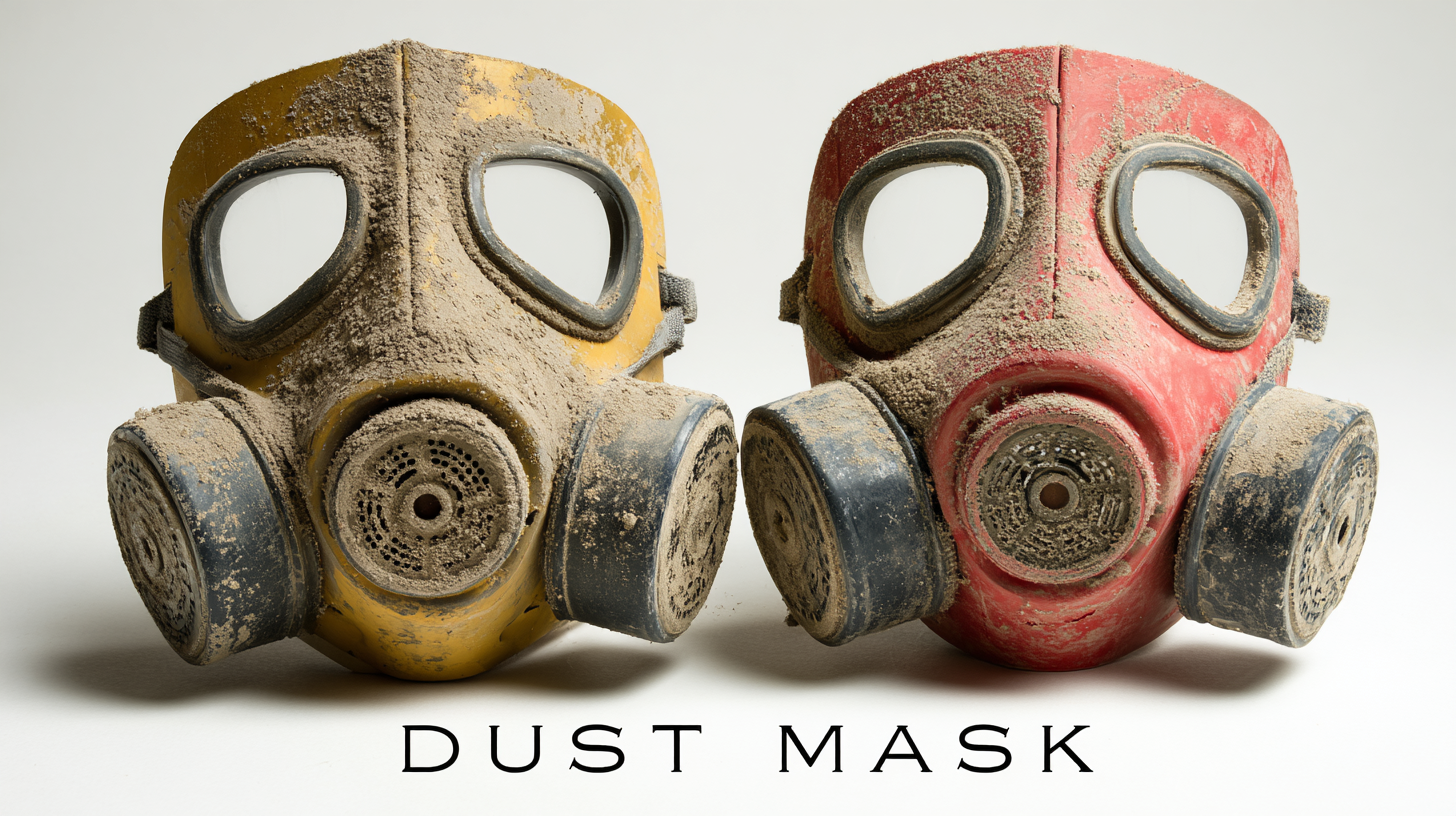
Ultimate Comparison of Top Rated Dust Masks for Global Buyers Insights and Metrics
In today's world, where air pollution and allergens pose significant health risks, selecting the right dust mask has become more crucial than ever. The market is saturated with various types of dust masks, making it imperative for global buyers to have access to insightful comparisons and metrics that highlight their effectiveness and suitability.

From N95 respirators to simple cloth coverings, each dust mask serves different purposes and environments. This ultimate comparison delves into the top-rated dust masks currently available, offering comprehensive insights that help consumers make informed choices. By examining factors such as filtration efficiency, comfort, and durability, this blog aims to guide readers in navigating the complexities of dust mask selection, ensuring they find the best protection for their specific needs.
Top Dust Masks: Analyzing Performance Ratings and User Satisfaction Metrics
Dust masks have become essential for various industries, and understanding their performance ratings and user satisfaction metrics is crucial for global buyers. According to a recent report by the National Institute for Occupational Safety and Health (NIOSH), masks that are rated N95 or higher provide at least 95% filtration efficiency against airborne particles, making them a key choice for users in construction and healthcare sectors. Additionally, the 2021 Respiratory Protective Devices Market Analysis indicated that user satisfaction is heavily influenced by comfort and fit, with over 70% of users reporting higher satisfaction when masks are adjustable and designed for extended wear.
User reviews also highlight that the materials used in dust masks significantly impact their perceived effectiveness. A comparative analysis from the Journal of Occupational and Environmental Hygiene revealed that masks crafted from multiple layers of high-quality fabric not only offer superior filtration but also enhance overall user experience.
One notable example is the 3M 8210 N95 respirator, which ranks high in both performance ratings and user satisfaction, backed by a reported 95% efficacy in filtering airborne particles, as per NIOSH's extensive performance tests. Such insights underline the importance of considering both technical ratings and user feedback when selecting the best dust masks for optimal protection and comfort.
Ultimate Comparison of Top Rated Dust Masks
This chart compares the performance ratings and user satisfaction metrics of top-rated dust masks based on user reviews and independent tests. The data showcases the effectiveness of dust masks against various pollutants and the overall satisfaction levels expressed by users.
Comparative Study: Filtration Efficiency of Leading Dust Masks and Their Ratings
In recent years, the increasing awareness of air pollution and workplace safety has heightened the demand for high-quality dust masks. A comparative study reveals that not all masks are created equal when it comes to filtration efficiency. According to a report by the American Industrial Hygiene Association, masks with a Minimum Particle Filtration Efficiency (MPFE) above 95% are crucial for protecting against fine particulate matter and harmful substances. Top-rated brands, such as 3M and Honeywell, boast efficiency ratings that often exceed this benchmark, making them favorites among industry professionals and everyday users alike.

Moreover, a survey conducted by Market Research Future highlights that 60% of consumers prioritize filtration efficiency when selecting a dust mask. The data indicates that masks with N95 and higher ratings not only provide superior protection but are also preferred for their comfort and fit. These findings underscore the importance of understanding the specifications and certifications of dust masks, as they directly influence user safety and performance in various environments, from construction sites to urban backdrops suffering from pollution.
Market Insights: Trends in Dust Mask Purchases and Consumer Preferences
The market for dust masks has witnessed significant evolution in recent years, primarily driven by increased awareness regarding health and safety. Consumers are becoming more discerning about the types of masks they purchase, focusing on factors such as filtration efficiency, comfort, and material quality. As pollution levels rise in many urban centers, the demand for high-quality masks has surged, prompting manufacturers to innovate and meet consumer needs. Metrics show that consumers are not just looking for a basic protective mask; they are willing to invest in products that provide superior protection and are comfortable enough for daily wear.
Additionally, trends indicate that eco-friendly materials are becoming a major selling point in the dust mask market. Shoppers are leaning towards brands that offer sustainable options, reflecting a growing preference for environmentally responsible products. Furthermore, the influence of social media and online reviews has reshaped purchase decisions, with consumers often relying on peer feedback and expert endorsements before making a purchase. This shift underscores the importance of transparency and brand reputation, as buyers seek to align their values with their purchasing choices in today's marketplace.
Expert Recommendations: Key Features and Ratings for Optimal Dust Mask Selection
When selecting the ideal dust mask, understanding key features and ratings can significantly influence your purchasing decision. Expert recommendations highlight several critical characteristics that should be at the forefront of your evaluation.

Firstly, filtration efficiency is paramount; masks should ideally offer a minimum of N95-rated protection, capable of filtering out 95% of airborne particles. Additionally, comfort is essential for extended wear, with adjustable straps, breathable materials, and a snug fit ensuring that the mask stays in place without compromising the user’s experience.
Another important consideration is the mask's reusability. Many top-rated dust masks are designed for multiple uses, incorporating washable filters that not only save costs but also aid in environmental sustainability. Ratings from users can provide insights into real-world performance, with factors such as durability and ease of use offering valuable context. By emphasizing these key features, buyers can make informed choices tailored to their specific needs, whether for professional applications or day-to-day activities.
Data-Driven Tips for Choosing the Best Dust Mask for Various Applications
When it comes to selecting the best dust mask for your needs, data-driven insights can significantly influence your decision. Different applications call for specific features, and understanding these metrics is crucial. For instance, consider the mask's filtration efficiency, which is often measured by its ability to block particulate matter. A mask rated N95 or higher is essential for environments with hazardous dust, such as construction sites or industrial settings. In contrast, everyday activities like gardening may only require a lower-grade mask, making it essential to assess your specific use case before making a purchase.
Another key metric to evaluate is comfort, which can greatly enhance compliance in prolonged use. Look for adjustable straps, breathable materials, and a design that fits securely without compromising on protection. User reviews and ratings provide valuable insights into real-world performance, shedding light on aspects such as durability and ease of cleaning. By leveraging data on both the protective features and user experiences, you can make an informed choice that aligns with your requirements and ensures optimal safety.
Ultimate Comparison of Top Rated Dust Masks for Global Buyers Insights and Metrics
| Mask Type | Filtration Efficiency (%) | Comfort Rating (1-5) | Breathability (Pa/cm2) | Application Use |
|---|---|---|---|---|
| N95 Respirator | 95 | 4.5 | 3.0 | Construction, Healthcare |
| P100 Respirator | 99.97 | 4.0 | 2.5 | Hazardous Material, Industrial |
| Surgical Mask | 80 | 3.5 | 4.0 | Healthcare, General Use |
| Dust Mask | 65 | 3.0 | 5.0 | Home Improvement, Gardening |
| Reusable Face Mask | 70 | 4.0 | 4.5 | General Outdoor, Dust Protection |
